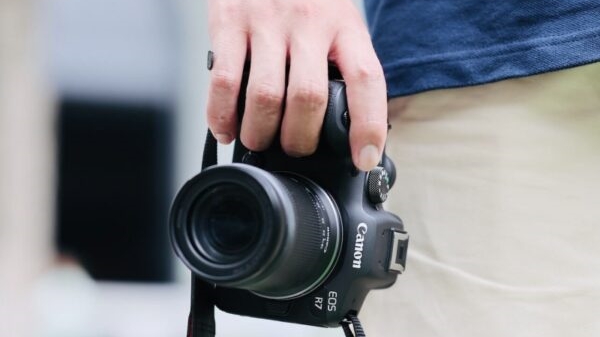
How To Keep Your Camera Strap From Fading
Within the first few moments of embarking on a photographic journey, your camera strap not only becomes a part of your gear but also an

Camera straps are an important but often overlooked camera accessory. The right strap can make carrying your camera much more comfortable and secure.
Most cameras come with a basic nylon strap, but upgrading to a leather strap has some major benefits. Here’s why you should consider making the switch to a leather camera strap.
One of the biggest advantages of a leather camera strap is comfort. Leather is softer, and more flexible, and molds your body better than nylon. This makes a big difference when you need to carry your camera for long periods.
The edges of a leather strap are less likely to dig into your neck and shoulders. Leather doesn’t irritate your skin as much as nylon either. This prevents the annoying red marks and discomfort nylon straps can cause.
Leather also develops a nice patina over time and conforms to your shape. This increases the comfort factor even more compared to stiff nylon straps. The flexibility of leather makes your camera feel like an extension of your body.
Many leather camera straps have extra padding for enhanced comfort. Thick padding on the shoulder and neck areas helps cushion the weight of your gear. It distributes the load more evenly, so you can wear your camera for hours without strain.
Padding also protects your neck from rubbing against any rough or sharp edges on the camera body. This prevents skin irritation or abrasions. Upgrade to a well-padded leather strap for the ultimate in-carrying comfort.
When you first get a new leather strap, it may feel a bit stiff. But after breaking it in, the leather softens up and conforms to your body. To speed up the break-in process, apply a leather conditioner. This helps soften up the material.
Wearing your new leather strap around for short periods helps shape it to your shoulders. The oils from your skin also help soften and condition the leather. Over time your strap forms to your body for maximum comfort.
Unlike nylon straps, the surface of leather develops a worn-in look the more you use it. Scratches and scuffs that occur while working add character to your strap. This gives it a nice vintage style as the years go by.
Some photographers actually prefer the imperfect, aged appearance of worn leather. It lends an air of experience and shows your strap has many travels and adventures with you and your camera.
For photographers who work up sweat lugging gear in hot climates, moisture-wicking leather straps are ideal. They use natural tanning oils that prevent the leather from getting slick when damp.
The material actively pulls moisture away from your skin to keep you cool and dry. This special leather treatment prevents sweaty slipping that can occur with regular leather or nylon straps.
Another big benefit of leather camera straps is they hold your camera more securely. Leather’s grippy surface texture helps prevent your camera from slipping off your shoulder. The material also doesn’t stretch or deform as much as nylon over time. This keeps your camera from bouncing around loosely while you walk or move.
High-quality leather has a natural non-slip surface that holds well against your clothing. This prevents the strap from sliding down your shoulder accidentally. The texture also keeps the strap securely anchored across your body as you move. You won’t have to constantly readjust a slippery nylon strap.
Examine the stitching on any leather strap you’re considering. It should use strong nylon or waxed thread to hold up over years of regular use. Sturdy reinforced stitching prevents the strap loops from tearing loose from the body of the strap.
Cheap stitching often snaps under the weight of heavy camera bodies with large lenses. This can lead to disastrous results. Always inspect the stitching closely before trusting your expensive gear to a new leather strap.
Photographers who work outdoors in all kinds of weather will benefit from weatherproofed camera straps. Treating leather makes it water resistant to prevent rain damage.
Oils applied during the tanning process also help repel snow, sleet, and mud. Weatherproof leather keeps your strap looking great despite harsh conditions. Your camera stays protected as well.
The connector hardware is one of the most important parts of any camera strap. Quality leather straps use robust attachment systems to keep your camera safely anchored.
Thick split rings allow you to securely screw the strap into the camera’s loops. Straps designed for quick disconnecting have sturdy snap hooks or carabiners made from steel or aluminum.
Avoid leather straps with flimsy plastic hardware or thin attachment points that could easily snap. Checking hardware quality ensures your camera won’t take a spill.
You have lots of options when choosing a leather camera strap. Here are some of the most popular styles:
This simple strap design loops around your neck like a necklace. Neck straps allow you to keep your camera close at hand and ready to shoot. They’re a lightweight and flexible choice, especially good for smaller cameras.
Shoulder camera straps are designed to keep your hands free and distribute the camera weight. They’re comfortable for the all-day carrying of heavy DSLR rigs. Padding and security features are especially important for shoulder straps.
Sling straps let you wear your camera across your chest bandolier-style. This makes access even easier while keeping your camera stable as you move. Sling straps are great for active shooting situations like travel, hiking, or street photography.
For the ultimate in versatile carrying, a hand strap frees up both hands when not shooting. But the strap securely anchors the camera to your wrist for safety. Hand straps offer easy grabbing and lifting for quick camera access.
Wrist straps attach your camera to your wrist like a bracelet. This allows you to safely dangle your camera at your side in between shots. Wrist straps provide security with flexibility. They work well with small mirrorless cameras.
Harnesses strap the camera across your chest like a vest, using a series of adjustable leather straps. This distributes heavy gear weight and minimizes strain on your neck and back. Harnesses allow you to shoot for hours without fatigue.
These specialty straps feature a quick-release system for instantly detaching your camera. They allow very fast switching to a tripod or monopod without fumbling with connectors. Useful for nature, sports, and action photographers who need split-second camera access.
Some high-end digital cameras feature custom leather straps already integrated into the body design. These give a low profile streamlined look perfect for sleek cameras. But you lose the ability to swap straps for greater versatility.
Here are a few tips to make sure you select the right leather camera strap for your needs:
Leather has some clear advantages over standard nylon camera straps:
However, leather still provides more pros for serious photographers. The leather develops a custom fit and personality no nylon strap can match. The comfort and security are worth the extra cost.
Over time a good leather camera strap actually saves you money. Quality leather lasts for years, making replacements less frequent. Check out leather options for your camera to simplify your shooting experience.
While a quality leather strap goes a long way toward protecting your camera, you can add a few extra accessories for even more security:
For ultimate peace of mind, choose a leather camera strap reinforced with steel cables inside. This prevents any chance of the strap stretching or breaking under sudden loads. Steel cable cores provide unbreakable strength for expensive heavy cameras.
These straps are designed so you can wear your camera across your back where thieves can’t access it. The long leather strap loops across your chest and connects to both sides of the camera. This keeps your gear safe in crowds.
Attach an inexpensive tether to your camera as a backup for your regular strap. If the main strap fails or disconnects, the tether prevents your camera from falling. A wrist tether gives an extra measure of security and can be detached easily.
Two layered straps with dual connecting rings and stitching add redundancy. Even if one layer fails, the second strap layer will support the camera. This helps protect against freak strap failures leading to accidents.
Leather straps do require a bit more care than nylon. Follow these tips to keep your strap looking and feeling new:
With occasional cleaning and conditioning, a quality leather camera strap will last for many years. It will come to show the scars of use while keeping your camera safe during all your photography adventures.
Once you fall in love with a handsome leather camera strap, you may want to complete the look with matching leather accessories:
Upgrading to a high-quality leather camera strap is one of the best investments you can make. Leather offers unparalleled levels of comfort, security, and style compared to basic nylon straps.
The supple material forms perfectly for your body while protecting your valuable photography equipment. As leather ages, it gains character unmatched by any synthetic material.
While leather costs a bit more than nylon, the benefits are worth it for serious photographers who rely on their gear. Treat your camera to the quality it deserves with a sturdy leather strap you’ll come to love more with each shoot.


Within the first few moments of embarking on a photographic journey, your camera strap not only becomes a part of your gear but also an

The moment you sling your camera strap over your shoulder, it becomes more than an accessory; it’s your camera’s lifeline, a bridge between you and

When it comes to photography gear, the camera strap might not be the first thing that springs to mind. Yet, this humble accessory is the

Your camera strap might seem like a small part of your photography gear, but it’s the lifeline that keeps your precious camera from taking a

Within the first few moments of embarking on a photographic journey, your camera strap not only becomes a part of your gear but also an

The moment you sling your camera strap over your shoulder, it becomes more than an accessory; it’s your camera’s lifeline, a bridge between you and

When it comes to photography gear, the camera strap might not be the first thing that springs to mind. Yet, this humble accessory is the

Your camera strap might seem like a small part of your photography gear, but it’s the lifeline that keeps your precious camera from taking a
Copyright © 2024 photocamerastrap. All Rights Reserved.